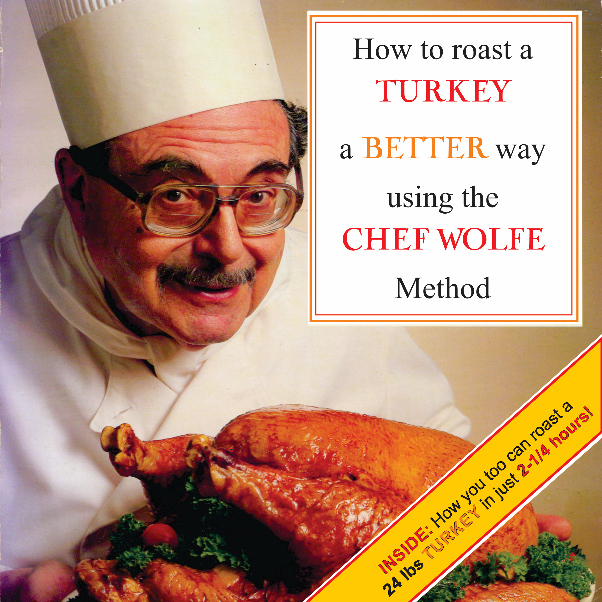| CHEF WOLFE’S METHOD FOR ROAST TURKEY |
|
A number of years ago I had the pleasure of studying Culinary
Arts under the direction of Chef Kenneth C. Wolfe. Chef Wolfe
was the founder and chair of the Culinary Arts Department at
Contra Costa College in California and was not only one of the
best teachers I’ve ever had, he both taught and inspired many
of the great Chefs working in the San Francisco bay area and
beyond. One of the techniques that Chef Wolfe’s students learned was his method for roasting turkey: One of the greatest culinary travesties that has been adopted
as tradition by most Americans is the way we cook our
traditional thanksgiving dinners. The problem is, a 20-plus pound turkey is not ‘designed’ to be effectively roasted whole, and especially not whole AND filled with stuffing. If you just look at the geometry of a turkey you will see that some parts are thick, some are thin and in order for the heat of your oven to penetrate far enough through the thick parts of the breast and legs to cook the stuffing to a safe degree, well, by the time that happens, significant parts of the outside of the bird will be overdone. This is why most people’s idea of a traditional roast turkey involves dry white meat, and barely moist dark meat (as the Turkey’s legs and thighs tend to dry out less quickly than the breast). For comparison, if you think about a common "Rotisserie Chicken" you can get at a big box store or your local supermarket, note that the white meat is likely far more juicy than the traditionally roasted turkeys you've had in the past. This is because those rotisserie chickens are simply not overcooked like the turkeys were. Yet this mal-cooking of turkeys happens time and again in
millions of households across the country every year come
November. Why? Well, it has to do with a thing called tradition.
Here is a story that Chef Wolfe told his students each year
about tradition: "How do traditions in cooking develop? Let me tell
you a story. A young husband was seated at dinner and asked
his wife why she cut off the ends of the ham. She replied,
'Because my mother always did it that way' When he next saw
his mother-in-law, he asked her why she cut off the ends of
the ham. She answered, 'Because my mother always did it that
way.' Fortunately, the old grandmother was still alive, so
the next time he saw her he asked, `Grandmother, why do you
cut the ends off your ham?' `So it would fit in the pan I
had,' she replied." In order to try and get around the physics of the problem, and the subsequent overdone turkeys, people have engaged any number of methods and devices to try and keep their Thanksgiving turkeys moist….foil tents, basting, cooking breast side down, basting, pop-up thermometers, basting…etc….ad nauseum. All of this effort and the turkeys STILL turn out FAR less moist than they could, if only folks actually learned to cook the darned things correctly. Chef Wolfe taught his students that instead of trying to fight a losing battle against physics, if you are willing to let go of a little tradition, and take that unwieldy, uneven cooking whole turkey and cut it into relatively similarly-sized pieces which will cook evenly, you will end up with a perfectly cooked turkey that is far better than what you’ve been accustomed to. Here then, is Chef Wolfe’s Turkey Roasting Method. The text and images are excerpted from the book, Chef Wolfe’s New American Turkey Cookery with a few minor edits and additions from yours truly. (Click on image above for PDF document) Now, you may note that this method is not too far
from Spatchcocking (or butterflying) your turkey. It's actually
functionally the same, the only difference is that this method
leaves the breast section standing a little taller which ends up
with a more traditional look (after you reassemble the bird as
the method shows) if that is important for your Thanksgiving
tradition. Enjoy, -Patrice aka Chef Juke |

